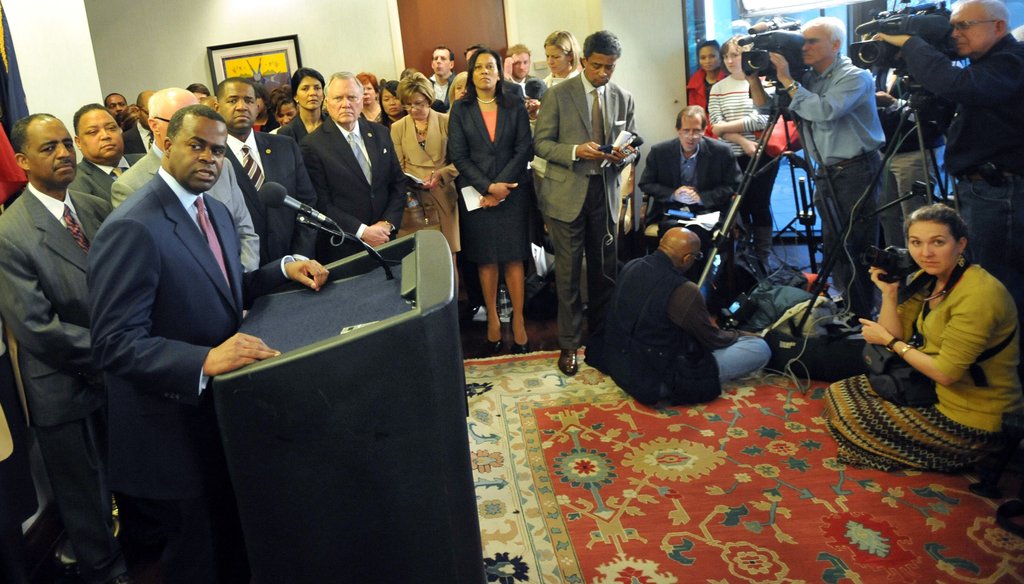Stand up for the facts!
Our only agenda is to publish the truth so you can be an informed participant in democracy.
We need your help.
I would like to contribute

Atlanta Mayor Kasim Reed, standing at the microphone, takes a question from a reporter during a March 7, 2013 press conference to announce a deal with the Atlanta Falcons on a $1 billion stadium.
Atlanta Mayor Kasim Reed and Atlanta Falcons owner Arthur Blank announced recently they’ve agreed to the financial framework of a $1 billion stadium to replace the 20-year-old Georgia Dome.
The deal must still be approved by the 15-member Atlanta City Council.
PolitiFact Georgia thought it would be useful to present some summaries of several fact-checks we’ve done of claims about the proposed stadium. The complete versions can be found on www.politifact.com/georgia.
Readers can comment on our rulings by going to our Facebook page at www.facebook.com/politifact.georgia.
Kasim Reed: The Georgia Dome would need up to $350 million in work over the next five to seven years.
Reed cites figures from a 2010 study that puts the dome’s renovation costs at about $393 million. Those renovations would include 369,000 square feet of additional space, a roof replacement and upgrades to the seating bowl/field area. Using these figures, the renovations would be more than the $200 million public investment in the proposed deal for a new stadium.
A study the following year, completed by the same company, lists maintenance and capital costs to keep the dome at "today’s" levels between $79.5 million and $114.5 million. Those costs would include basic renovation items such as technology and plumbing upgrades, along with a new roof.
Using these figures, the renovation cost would be less than the $200 million public investment into the proposed new stadium deal.
The difference lies with which style of renovations is chosen: the exclusive Rolls-Royce level of renovations or the cheaper, base model Honda level of renovations. We rated the mayor’s claim Half True.
Duriya Farooqui: "Of the 18 stadiums built between 2004 and 2013, 47 percent of the total cost came from public sources."
Farooqui, the mayor’s second-in-command, made the claim during the first presentation about the stadium inside a crowded meeting at City Hall.
In the past decade, 18 multimillion-dollar facilities were built for professional sports teams. These facilities cost a combined $11.7 billion to build, with a public contribution of about $5.6 billion, or 48 percent of the total cost.
Of the four venues that cost $1 billion or more to build, the public investment was about 18 percent, two percentage points less than the Atlanta project would require.
The claim is on target, even if you remove arenas. But the public investment in billion-dollar stadiums was much less than 47 percent. We believe this context is necessary to fully understand Farooqui's statement. We rated Farooqui's claim Mostly True.
Vincent Fort: "What concerns me is there is only two sentences that have been written about minority business."
The state senator from Atlanta is worried minority-owned businesses will be largely left out if and when the time comes to hand out contracts to build the new stadium.
Thus far, a term sheet laying out a nonbinding blueprint for the stadium and operations has been approved. Fort uses the brief minority business mention in the term sheet as a reason to be leery of the state's promise to carry out minority participation promises.
A look at the term sheet shows that Fort's statement is mostly correct. But more explanation is needed. City leaders are pushing for almost a third of the work to be done by minority businesses, and team executives have said they will offer equal opportunities. But the devil is in the details, and those details have not been worked out.
Fort's statement is partially accurate but needed a lot of additional information. We rated Fort's claim Half True.
Zell Miller: "[T]he Georgia Dome has returned $10 billion in economic impact to the state of Georgia."
The former Georgia governor and U.S. senator made his claim in an op-ed. Miller is a consultant and adviser for the law firm, McKenna, Long & Aldridge, which is working with proponents of the new stadium.
Miller, however, was using errant data provided to the firm by the Georgia World Congress Center Authority, which owns and operates the Georgia Dome. There was a glitch in the formula they used to make the estimate. From our research and conversations with other experts, we concluded the dome’s economic impact is likely between $5 billion to $7.5 billion.
We rated Miller’s claim as False.
Our Sources
See attached articles.























































